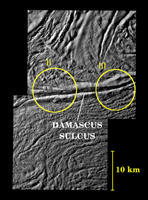
High resolution annotated versionCassini shot past the surface of Saturn's moon Enceladus on Aug. 11, 2008, acquiring a set of seven high-resolution images targeting known jet source locations on the moon's "tiger stripe" fractures, or sulci. Two of those images are presented in this mosaic; the other five images are shown in PIA11114.
Features on Enceladus are named for characters and places from "The Arabian Nights," and the four most prominent sulci are named Alexandria, Cairo, Baghdad and Damascus. Here, Damascus Sulcus runs across the center, from left to right.
One highly anticipated result of this flyby was to pinpoint previously identified source locations for the jets that blast icy particles, water vapor and trace organics into space (see PIA08385). The yellow circles on the annotated version of the mosaic indicate source locations II and III identified in PIA08385).
Scientists are using these new images to study geologic activity associated with the sulci, and effects on the surrounding terrain. This information, coupled with observations by Cassini's other instruments, may answer the question of whether reservoirs of liquid water exist beneath the surface.
The mosaic consists of two images obtained with the clear spectral filters on Cassini's narrow-angle camera. The view is an orthographic projection with an image scale of 24 meters (79 feet) per pixel. The area shown here is centered on 81.2 degrees south latitude, 309.9 degrees west longitude. The original images ranged in resolution from 27 to 30 meters (89 to 98 feet) per pixel and were taken at distances ranging from 4,200 to 4,742 kilometers (2,610 to 2,947 miles) from Enceladus.
The Cassini-Huygens mission is a cooperative project of NASA, the European Space Agency and the Italian Space Agency. The Jet Propulsion Laboratory, a division of the California Institute of Technology in Pasadena, manages the mission for NASA's Science Mission Directorate, Washington, D.C. The Cassini orbiter and its two onboard cameras were designed, developed and assembled at JPL. The imaging operations center is based at the Space Science Institute in Boulder, Colo.
For more information about the Cassini-Huygens mission visit http://saturn.jpl.nasa.gov/. The Cassini imaging team homepage is at http://ciclops.org.

